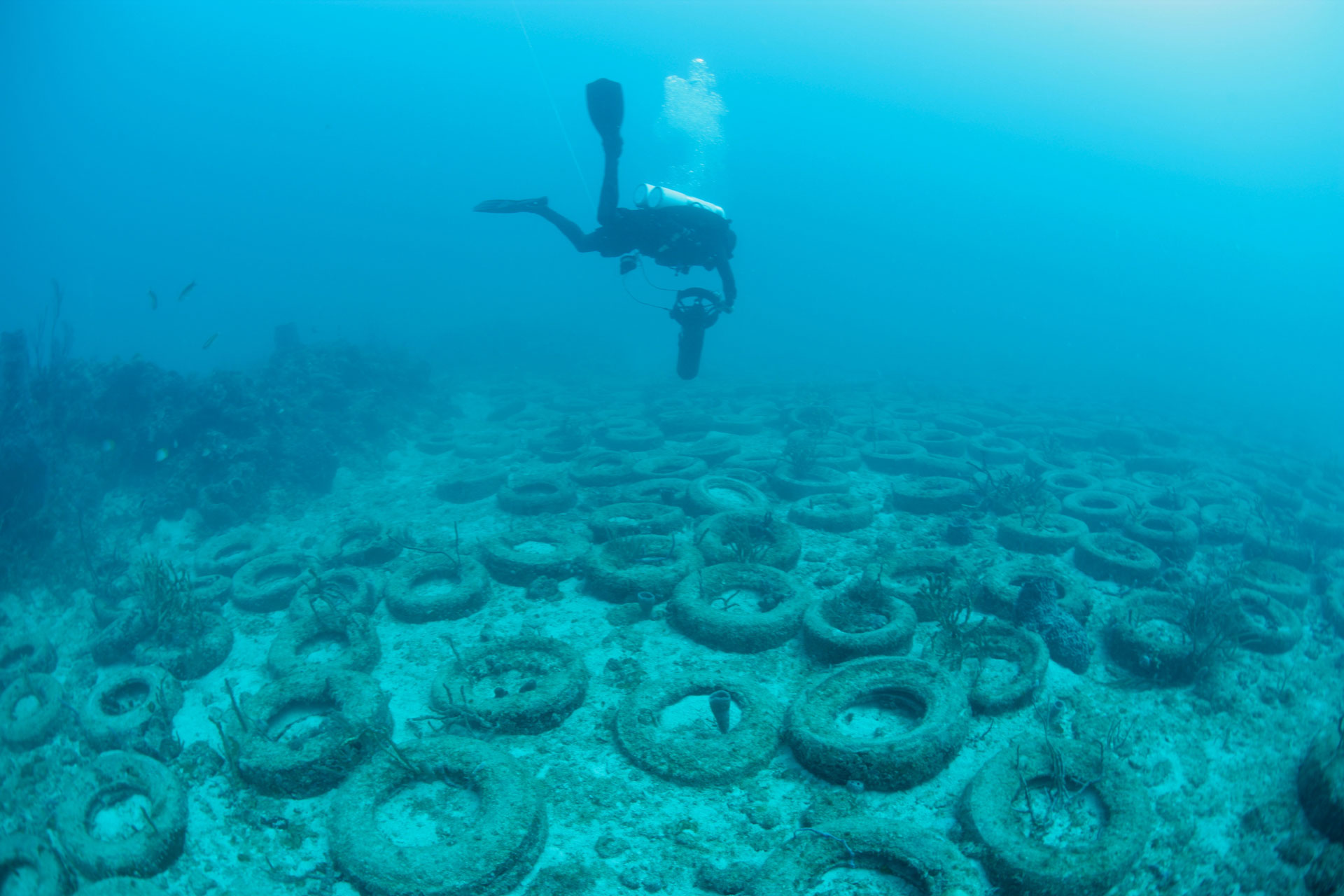The idea of using discarded tires to build man-made reefs in order to attract sea life and coral growth has been tried many different places all over the world. But it appears that all such projects eventually have failed miserably – some even
disastrously.
The image below shows a barge used in the deployment of discarded tires onto the Osborne Reef in the hopes of expanding the man-made reef further and to attract more marine life. Some 2 million tires were eventually dropped onto the Osborne Reef covering an area of about 34-36 acres not counting the migrated tires.

Barge used to deploy discarded tires in building the Osborne Tire Reef off the coast of Fort Lauderdale Florida
In previous posts we have described how these tires at the Osborne Tire Reef failed completely at attracting corals and algae growth onto them and how the tires which were originally bound together by nylon and metal clips eventually came loose and now shift around in heavy weather conditions and storms.

Tires bundled up before deployment
The loose tires migrates and they are especially migrating towards the shore where they sometimes actually wash up on the beach. But before they reach the shore they will pass through the natural reef. Upon meeting the natural reef the tires sometimes bash into it, move on top of it and across the top of it. This causes tremendous damage to the natural reef that has taken decades to generate.
Similar troubles have been experienced elsewhere where “tire reefs” have been deployed. In Virginia they created a tire reef, but when Hurricane Bonnie passed by in 1998, the tires got loose and a lot of them ended up in North Carolina. Some 170,000 tires were eventually fished out of the waters in North Carolina in the clean up that pursued.
Man-made reefs are by no means all failing and many actually do attract much marine life and growth. A number of vessels have been decommissioned, cleaned and stripped of hazardous materials and have intentionally been sunk to form a man-made reef. Many of these form great attractions not just for the marine life, but also for the divers and as they attract many fish, they are popular with fishermen too.
The tire reefs, however, never realized much natural growth on them and thus never attracted much marine life either. Theories about the non-forming of natural growth include the possibility that the rubber oozes off certain toxins, but perhaps more likely theories seem to converge on the fact that the tires simply are too light and thus too mobile thereby hindering the growth.
And mobile they are indeed, especially when they are no longer tired down and bound together. Project Baseline Gulfstream recently – May 18th 2013 – surveyed parts of the Osborne and the surrounding area to the West of the Osborne Reef towards shore and on the natural reef, including Fisherman Pedestal. The dive was videoed and several still images were captured. The video and the still shots tell very apparently a grim story of tires now scattered all about, with a large number of them piled up against the natural reef and with many more scattered about on top of the natural reef.
“The dive was my first visit ever to Fisherman Pedestal. It looks like such a beautiful reef, but it also looked like it had taken many beatings. It was shocking to see so many tires scattered about along the edges and so many on top of the reef”, said Mikkel Pitzner, one of the Project Baseline Gulfstream dive team members performing the survey, about the experience.
Another dive team member, Robert Carmichael, added: “I’ve been diving this location many times over several decades and I have never seen it this bad”.
New Jersey tried at one point to hinder the mobility and alleviate the lightness of the tires in a “test” reef they were constructing in 1986 consisting of 1,000 tires. They split the tires in half, bound them together and weighted them down with concrete. This didn’t work successfully as pieces of rubber broke free and ended up washing ashore along the beaches and elsewhere.
Other methods of stacking the tires and filing them up with concrete also proved to be fruitless and unsuccessful.
Indonesia and Malaysia have also established tire reefs and are also beginning to experience adverse outcomes. Tire reefs are also present in Africa and Australia.
There have been a few tire removal programs and efforts for the Osborne Tire Reef previous, but collectively if this writer’s research is true the tires collected/retrieved amounts to less than 150,000 tires. Florida Department of Environmental Protection has just had posted a Request for Proposals (RFP) for Osborne Reef Tire Abatement Services which deadline just closed this week. The current tire removal projects only directs attention to certain parts of the Osborne Tire Reef at this point in time.
Regrettably, the most urgent areas that would include the natural reef and Fisherman Pedestal are not included.
More on this story to come…
Stay tuned on the project by signing up for our newsletter using the sign up form in the top right hand corner of website

Image above is taken May 18, 2013 at the South Western part of the Osborne Tire Reef, Florida. Photo Credits, All Rights Reserved: Mikkel Pitzner
